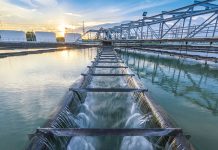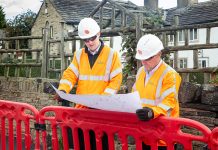Undeniably one of the major challenges in the AMP6 wastewater delivery programme – and well into AMP7 – are the strategies, technologies and scale of the requirements to meet the ultra-low total phosphate standards across the industry.
By Guy Forrest-Hay
Business Development – UK and Ireland,
De Nora Water Technologies
TOTEX, innovation, modularisation, build-off-site and unmanned works are obviously aspects within the sector that need ongoing focus, but achieving stringent phosphate and metal consents in the most sustainable manner possible is, I believe, the biggest test of them all.
Uncharted territory?
Interestingly, the underpinning principles of chemical dosing, coagulation, flocculation and ultimately filtration are amongst the best understood and most widely applied across the sector, but applying them to deliver the ultra-low levels is challenging and still, to a large degree, uncharted territory.
As someone involved with both clean and wastewater process for over 20 years, I believe this challenge to be over and above those previously faced. The high-level dosing of metal salts throughout the process (typically ferric sulphate) has never been attempted before in wastewater, and certainly not upfront of existing and proposed tertiary treatment plants.
Whilst water companies and partners across the industry are working intensively to find the best solutions, I believe this may not be the time to be taking major leaps of faith with new technologies/processes supported by ambitious claims. To focus on tried and tested processes that have been continually improved over many collaborative projects throughout the AMP periods, may well be the right way to go.
Engaging with industry
De Nora has been listening and engaging with many of the leading minds to keep abreast of the work being undertaken, the likely strategic directions and, crucially, what key suppliers and Original Equipment Manufacturers (OEMs) can bring to the table.
The UK Government Science and Technology Select Committee has revealed that the cost of implementing the Water Framework Directory (WFD) in the UK could be as much as £30 billion, with an associated operating cost of an extra £30 million per annum thereafter.
From recent conversations, it appears that 30 to 40 low P scheme projects per water company is not atypical, and the majority of these are still very much in the starting blocks. As is often characteristic of the wastewater side of the sector, every site has unique aspects – influent, imports, hydraulics, existing tertiary stages – but there is still scope for the ‘holy grail’ of standardisation.
Team-led approach
Although the UK, through its CIP1 & CIP2 (Chemical Investigation Programmes) is further ahead than most other EU countries in terms of understanding, there is still so much more to do in terms of cost effective strategies, technologies and techniques to remove these substances.
Proven technology solution providers and innovators in the supply chain are passionate about bringing their know-how to the table and playing a larger role in meeting these challenges. Amidst the ongoing debate that water companies may derive benefits from closer engagement with key suppliers, a more refreshing collaborative approach is being taken – guided by UK Water Industry & Research (UKWIR) and the CIP2 programme.
As such, we are looking forward to the Big P Conference and Exhibition, on 4-5 July, in Manchester, which will be a key step forward in sharing the key findings of the trial work, and to start to develop the future pathway.
In our discussions with water companies, the following themes seem most prevalent:
• The supply chain is valued and needed, particularly in the elements of tertiary treatment to remove phosphate and residual metals, as well as chemical dosing.
• An increased scope of ownership and input would be favourable, particularly in the areas of coagulation and flocculation.
• There is a strong desire for enhancements to existing technologies to meet the increasing requirements, such as removing an additional flocculation stage and asset.
Expertise and Experience
As a trusted supplier, with TETRA Modular and DeepBed Filters amongst the most widespread of tertiary treatment assets, De Nora is committed to playing a leading role in working with our valued clients and the wider sector to deliver this programme.
Across the business, De Nora has significant expertise in coagulation/flocculation processes, through our range of BALPURE® ballast water systems and OMNIPURE™ sewage treatment solutions for the marine industry. This expertise is being aggregated and we are well advanced in enhancing the TETRA offerings to include the coagulation and flocculation processes via a dedicated zone above the media bed. Not only will this optimise residence time and G Values, but allows variation in line with influent flows to ensure the formulation of the small flocs required for P removal – but still large enough to be removed by the TETRA media to ensure compliance.
De Nora is also evaluating truly innovative medias that can be retrofitted to existing TETRA filters to assist with phosphate removal as well as further key Priority Substances.
B-minded
Despite the challenging landscape, environmental compliance has barely featured in the hours of chat about the dreaded ‘b’ word, Brexit. In my opinion, the need for solutions and compliance will be with us for the next 10-15 years. As a key supply chain partner, De Nora certainly relishes the opportunity to meet this challenge head on.
I hope to see you all in Manchester.
Disclaimer: The views and opinions expressed in this article are those of the author and do not reflect the official position of De Nora Water Technologies.





